DIY Guide: How to Clean AC Coils Like a Pro and Boost Your Cooling Efficiency
Hey there, folks! Keeping your air conditioning system in tip-top shape is not just about staying cool—it’s about saving money and extending the life of your unit. One task that often gets overlooked is cleaning those AC coils. Trust me, I’ve seen too many systems struggle because of dirty coils, leading to higher energy bills and less cooling power.
In this guide, I’ll walk you through the simple steps to clean your AC coils, just like I’ve done countless times in my 20 years as an HVAC tech. Whether you’re a DIY pro or just starting out, you’ll find this task is easier than you think. So, grab your tools, and let’s get your AC running like a champ!
Why Cleaning AC Coils is Crucial
Let me tell you, regular maintenance of your air conditioning system is like giving your car a tune-up. It’s essential for keeping things running smoothly, and cleaning those AC coils is a big part of it. When you clean AC coils regularly, you’re not just doing your AC a favor—you’re doing yourself one too. This simple task boosts your air conditioner’s efficiency, which means it uses less energy. And who doesn’t like lower energy bills? Plus, keeping those coils clean can extend the lifespan of your unit, saving you from shelling out big bucks on repairs or replacements later on.
Now, I’ve seen it time and again—dirty coils are often the sneaky culprits behind those sky-high energy bills and that frustratingly inefficient cooling. When dirt clogs up the coils, your air conditioner has to work overtime to cool your home. This means more energy consumption and, sadly, more chances of a breakdown. And trust me, nobody wants their AC to quit on them during a heatwave. So, keeping those coils clean isn’t just about efficiency; it’s about reliability and avoiding those unexpected, sweaty surprises.
Here’s the thing: clean coils are crucial for optimal heat exchange, a process that’s key to your AC’s smooth operation. When the coils are spick and span, they allow for better heat transfer, ensuring your air conditioner runs like a dream. This helps prevent common headaches like frozen coils or that annoying constant fan operation. By keeping the coils clean, you’re making sure your AC system is at its best, giving you consistent and reliable cooling all year round.
Identifying When Your AC Coils Need Cleaning
Knowing when to give your AC coils a good clean is key to keeping your system running smoothly and efficiently. One clear sign that it’s time for a cleaning is when your AC isn’t cooling as well as it used to. If you notice your home isn’t as comfortable, it might be those coils acting up. This drop in performance often means your energy bills are climbing, as the unit struggles to keep up.
Another red flag is a funky smell coming from your air conditioner. This odor is usually dirt and debris having a party on your coils, and it can mess with your home’s air quality. Tackling this issue quickly can save you from bigger headaches down the road and keep your home smelling fresh.
Regular check-ups are your best friend when it comes to spotting dirty coils before they cause trouble. By taking a peek at your AC unit now and then, you can catch dirt and grime early, giving you a chance to clean things up before they get worse. This hands-on approach not only boosts your AC’s efficiency but also helps it last longer, sparing you from expensive fixes and replacements.
Signs of Dirty AC Coils
Dirty AC coils can throw a wrench in your cooling system’s performance. One telltale sign is a drop in cooling efficiency. When dirt and debris coat the coils, they can’t absorb and release heat like they should. This means your home isn’t as cool as you’d like it to be. Plus, your AC has to work overtime, leading to higher energy bills. If you notice your electricity costs climbing without a good reason, those coils might be the sneaky culprits.
Another red flag is the presence of funky odors wafting from your AC. Dust and grime on the coils can invite mold and bacteria to the party, and they don’t smell great. This not only messes with your indoor air quality but also signals that your coils need some TLC.
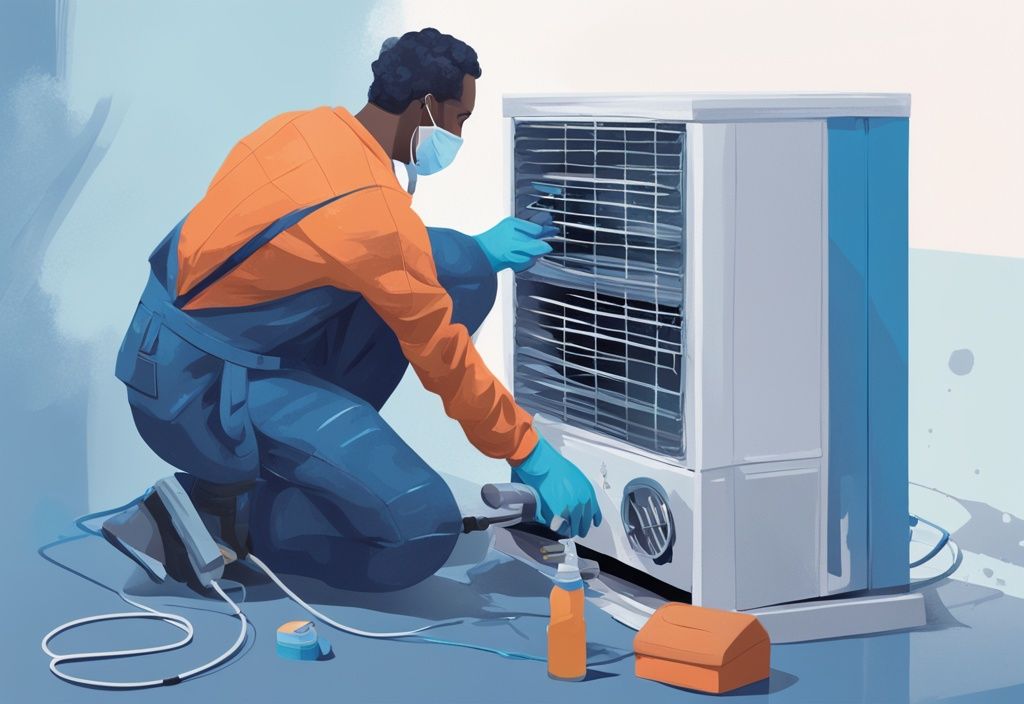
Finally, a quick visual check can tell you a lot. If you spot dirt and debris on the coils, it’s a clear sign they need cleaning. Regular inspections are your best friend here, helping you catch issues early and keep your AC running smoothly.
Preparing for AC Coil Cleaning: Safety Measures and Tools
Before diving into the nitty-gritty of AC coil cleaning, it’s crucial to put safety first and gather the right tools for the job. Start by switching off the power to your air conditioning unit. This is a must-do step to dodge any chance of getting an electrical shock. Head over to the breaker and flip it off to ensure you’re in the clear during the cleaning. Also, make sure the condenser coils are cool to the touch before you begin. This little check can save you from burns and keeps the coils safe from damage during cleaning.
Essential Tools for Cleaning AC Coils
Having the right tools on hand makes the cleaning process smoother and safer. First up, grab a pair of gloves to keep your hands safe from dirt and sharp edges. A trusty flashlight is your best friend for lighting up those hard-to-see spots, ensuring no debris is left behind. You’ll also need a screwdriver or drill to get to the coils by removing panels or covers.
When it comes to the actual cleaning, a scrub brush is your go-to for tackling stubborn dirt and grime. A hose with a sprayer attachment will help you rinse off the coils, while a shop vacuum with a wand extension is perfect for sucking up loose debris. A fin comb is a handy tool for straightening any bent fins, which is key for optimal airflow. Lastly, have some soap and a coil cleaner ready to give those coils a thorough clean, leaving them in tip-top shape for efficient operation.
Understanding the Location of AC Coils
Air conditioning systems are like a well-oiled machine, relying on two main types of coils: evaporator coils and condenser coils. Knowing where these coils are located is key to keeping your AC running smoothly.
Evaporator Coils
Now, let’s talk about evaporator coils. These guys are tucked away inside the indoor unit of your air conditioning system. Their job? Absorbing heat and humidity from the air in your home, making it nice and cool. Picture them as the unsung heroes working behind the scenes. They’re usually found inside the air handler or furnace, which means they’re a bit tricky to get to. But don’t let that stop you! Regular checks and cleaning are crucial. Dust and grime can build up, making it harder for them to do their job. So, roll up your sleeves and give them some TLC.
Condenser Coils
On the flip side, condenser coils are stationed outside, in the outdoor unit of your AC. Their mission is to release the heat absorbed from your home into the great outdoors, completing the cooling cycle. Since they’re out in the open, they’re more prone to collecting dirt, leaves, and all sorts of debris. It’s like they’re magnets for muck! That’s why it’s super important to keep them clean. A clean condenser coil means efficient heat exchange and fewer headaches down the road.
How to Clean AC Coils: A Detailed Guide
Cleaning your AC coils is essential for maintaining the efficiency and longevity of your air conditioning system.
This guide breaks down the process into simple steps, making it easy for you to tackle this task yourself.
Preparing Your AC Unit for Cleaning
First things first, safety is key. Before you start, make sure to turn off the power to your AC unit. Trust me, you don’t want any unexpected zaps! Once the power is off, let the unit cool down completely. This prevents burns and gives you a safe start. Carefully remove the outer casing and any protective caging. Just be sure not to mess with the bolts holding the fan to the lid. This setup primes you for a smooth cleaning session without causing any damage.
Cleaning Outdoor Condenser Coils
Now, let’s get to those outdoor condenser coils. Start by removing the covers and the fan to get a clear view. Grab a small broom or hand brush and gently sweep away debris and any broken aluminum fins. You might find a few surprises here, like leaves or dirt. If you’ve ever wondered why your car AC is not blowing cold air, it might be due to blockages like these. Why is my car AC not blowing cold air? This is a common issue that can often be resolved with some simple maintenance. Next, use a vacuum to suck up the dust particles. If you spot any bent fins, a fin comb will do wonders to straighten them out, ensuring optimal airflow. Apply a coil cleaner, scrub the coils with some soap, and give them a good rinse with a hose. Once everything’s sparkling, reassemble the unit, making sure all parts are snug and secure.
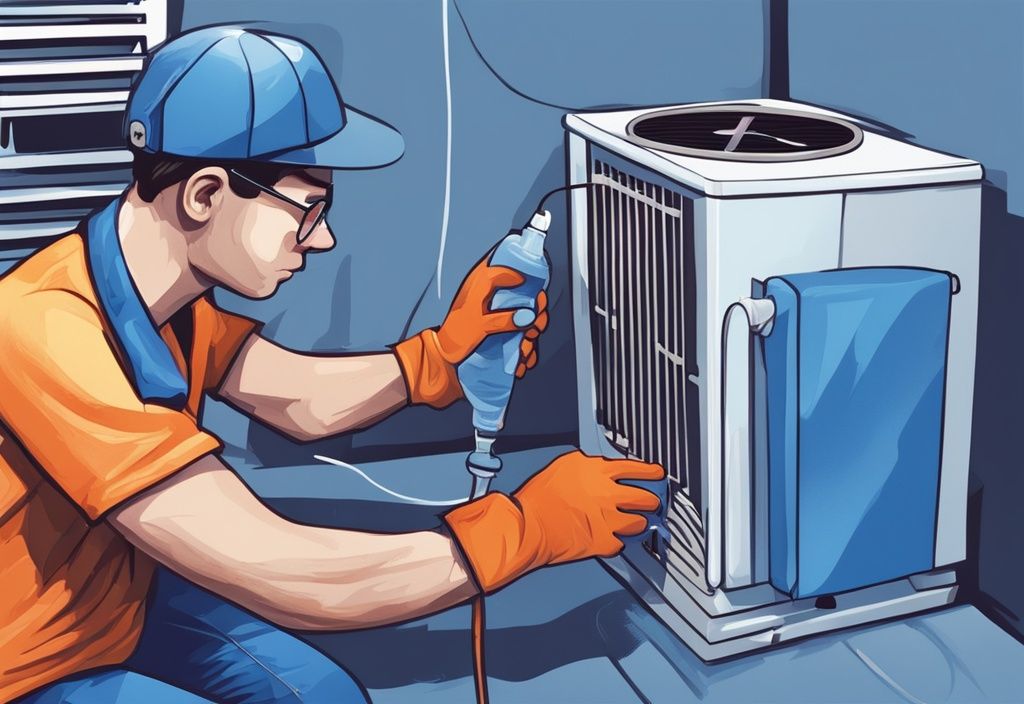
Cleaning Indoor Evaporator Coils
Time to head indoors for the evaporator coils. Remove the access panel to expose the coils. With them in sight, gently scrub away any dirt buildup. Be careful with those delicate fins; they’re easy to bend. If needed, straighten them to keep things running smoothly. A foaming cleaner works wonders to loosen debris. Brush off any leftovers, and use a spray bottle to rinse the coils thoroughly. After they’re dry, reattach the access panel securely. This careful cleaning keeps your AC unit running efficiently for years to come.
Choosing the Right Coil Cleaner
Cleaning AC coils is a task that can make a world of difference in how your air conditioning unit performs. The right coil cleaner can help you tackle this job efficiently, whether you opt for a commercial product or a homemade solution. Let’s dive into the pros and cons of each option.
Commercial vs Homemade Coil Cleaning Solutions
When it comes to how to clean AC coils, picking the right cleaner is key. Commercial coil cleaners are readily available and pack a punch when it comes to removing stubborn dirt and grime. These products are specially designed to handle tough residues, ensuring your AC runs smoothly. But, a word to the wise—some of these cleaners might contain chemicals that aren’t so kind to the environment. It’s crucial to follow the instructions on the label and weigh the environmental impact of using these products.
Now, if you’re leaning towards a greener option, homemade coil cleaning solutions might be your best bet. Simple concoctions like water and vinegar or a mild detergent can do wonders for cleaning AC coils without the harsh chemicals. These solutions are not only easier on Mother Earth but also gentle on your coils, minimizing the risk of damage during cleaning. Plus, they’re a cost-effective way to keep your AC in tip-top shape, especially for regular upkeep and lighter cleaning tasks.
Post-Cleaning Steps for Optimal AC Performance
So, you’ve tackled the job of cleaning your AC coils—well done! Now, let’s make sure your air conditioner is humming along nicely. First things first, restore the power. Head over to the breaker and switch it back on. Once your AC is up and running, take a moment to listen. Is it cooling better? Any strange noises? These are your first clues that everything’s in good shape.
Keeping your AC in top form means planning ahead. Regular maintenance is your best friend here. Jot down a reminder for your next coil cleaning—I’d say once a year is a good rule of thumb, but if you notice it’s not cooling like it used to, you might want to do it sooner.
Stay alert for any signs of trouble. Watch out for spikes in your energy bill, odd smells, or inconsistent cooling. If something seems off, don’t hesitate to call in a pro. It’s always better to catch issues early, ensuring your AC stays efficient and reliable.
When to Hire a Professional for Coil Cleaning
Cleaning AC coils is something many homeowners can tackle with the right tools and a bit of patience. But sometimes, it’s best to call in the pros. If your AC coils look like they’ve been through a mud wrestling match, getting them spotless on your own might be a tall order. Professionals have the know-how and the gear to handle even the grimiest coils, ensuring your air conditioner runs like a dream.
Feeling a bit uneasy about diving into coil cleaning? That’s perfectly normal. Without the right knowledge, you might end up doing more harm than good. A botched job can lead to poor cooling and those dreaded high energy bills. Professionals can navigate these tricky waters, giving you peace of mind and keeping your AC system humming efficiently.
Beyond just cleaning, pros can give your entire AC unit a once-over, spotting potential issues before they turn into costly repairs. This proactive approach doesn’t just save money in the long run; it also extends the life of your air conditioner. So, if you’re unsure or facing coils that look like they’ve seen better days, hiring a professional is a smart move to keep your AC in top shape.
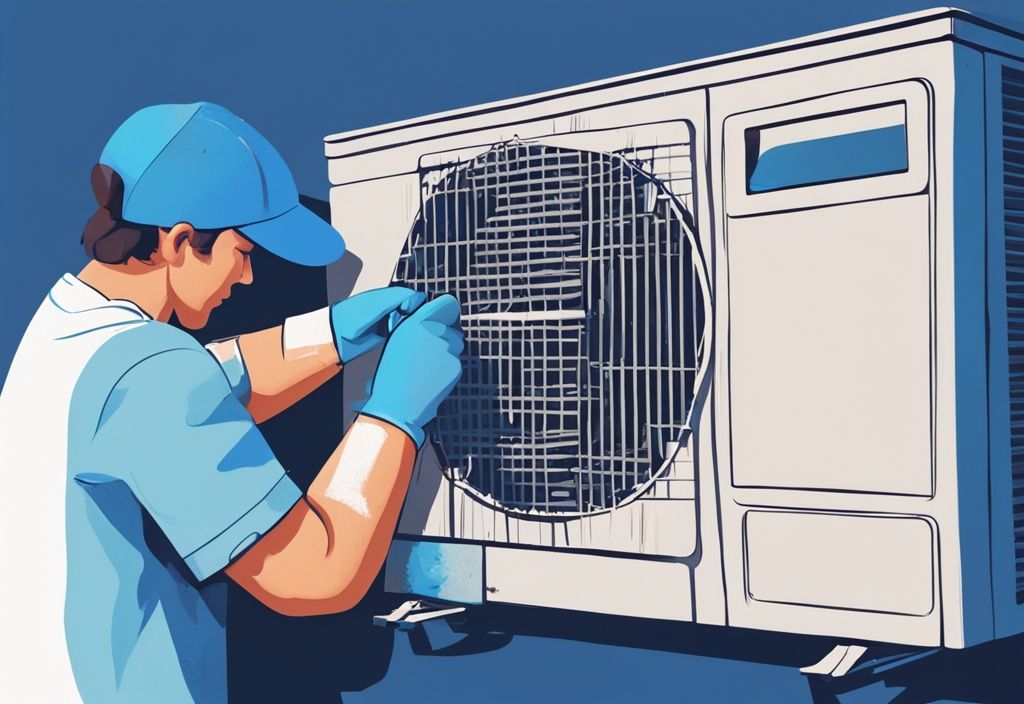
FAQ
Explore common questions about cleaning AC coils, with insights and tips from a seasoned HVAC technician.
How often should I clean my AC coils?
- It’s a good idea to give your AC coils a good cleaning at least once a year. This keeps your unit running smoothly and helps avoid any pesky problems down the road. Regular cleaning means your air conditioner is working at its best and can even last longer.
Can I clean AC coils myself, or should I hire a professional?
- With the right tools and a bit of caution, you can definitely clean AC coils yourself. But if they’re really dirty or you’re feeling unsure, it’s wise to call in a pro. They’ll make sure everything’s spick and span.
What are the signs that my AC coils are dirty?
- Dirty coils can make your AC less efficient, hike up your energy bills, and even cause some funky smells. Keep an eye out for these signs, and you’ll catch any issues early, making cleaning and maintenance a breeze.
Is it safe to use commercial coil cleaners?
- Commercial cleaners do the job well, but they might not be the best for the environment. Use them carefully, following the instructions to a tee. This way, you keep things safe and effective without harming Mother Nature.
What tools do I need to clean AC coils?
- You’ll want to have gloves, a screwdriver, a scrub brush, a hose, a shop vacuum, a fin comb, some soap, and a coil cleaner handy. These tools will help you clean those coils thoroughly and safely.
Conclusion: The Importance of Regular AC Maintenance
Regular maintenance of your air conditioning system, especially when it comes to how to clean AC coils, is a game-changer for avoiding major headaches and costly repairs. Think of it like giving your car a regular oil change. By making coil cleaning a routine part of your maintenance schedule, you’re ensuring that your AC unit runs smoothly and efficiently.
Clean coils are the unsung heroes of your AC system. They allow for optimal heat exchange, which is key to keeping your home cool and comfortable. Plus, when your coils are clean, your system doesn’t have to work as hard, which means lower energy consumption and, ultimately, a nice little bonus on your utility bills.
But that’s not all. Keeping those coils free from dirt and debris can significantly extend the life of your air conditioning unit. It’s like giving your AC a little TLC. Less strain on the system means fewer breakdowns and less need for those dreaded expensive repairs. This proactive approach not only protects your investment but also ensures your home stays a cool haven during those sweltering summer months.
So, by prioritizing regular AC maintenance, you’re not just maintaining a machine. You’re enhancing your home’s comfort and saving money in the long run. It’s a win-win situation that keeps your system humming along happily.
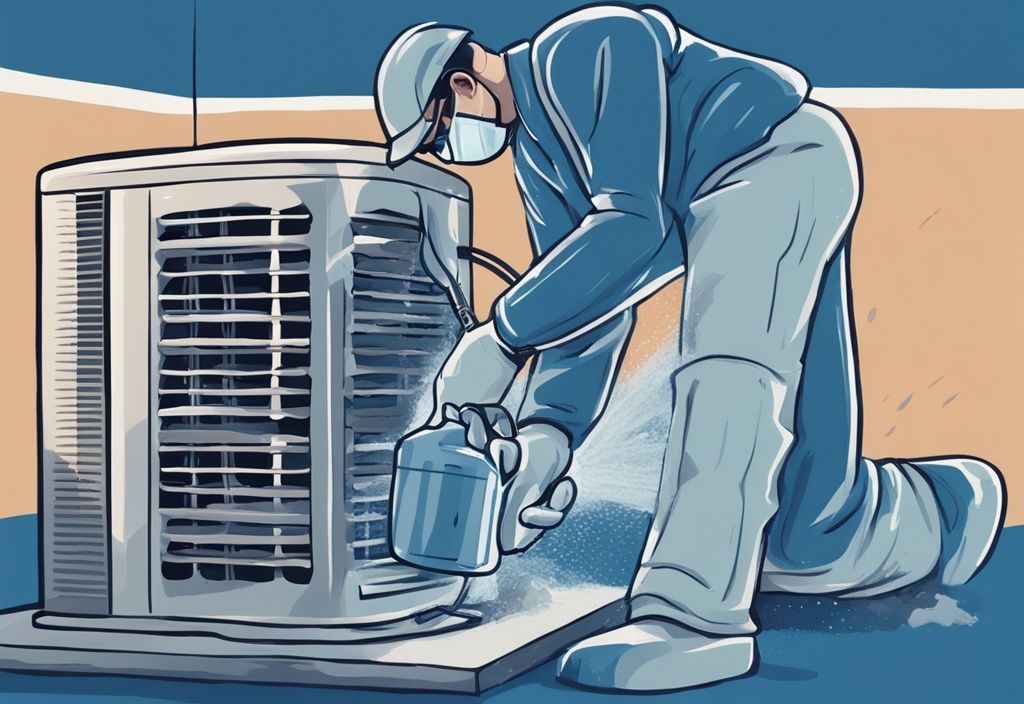
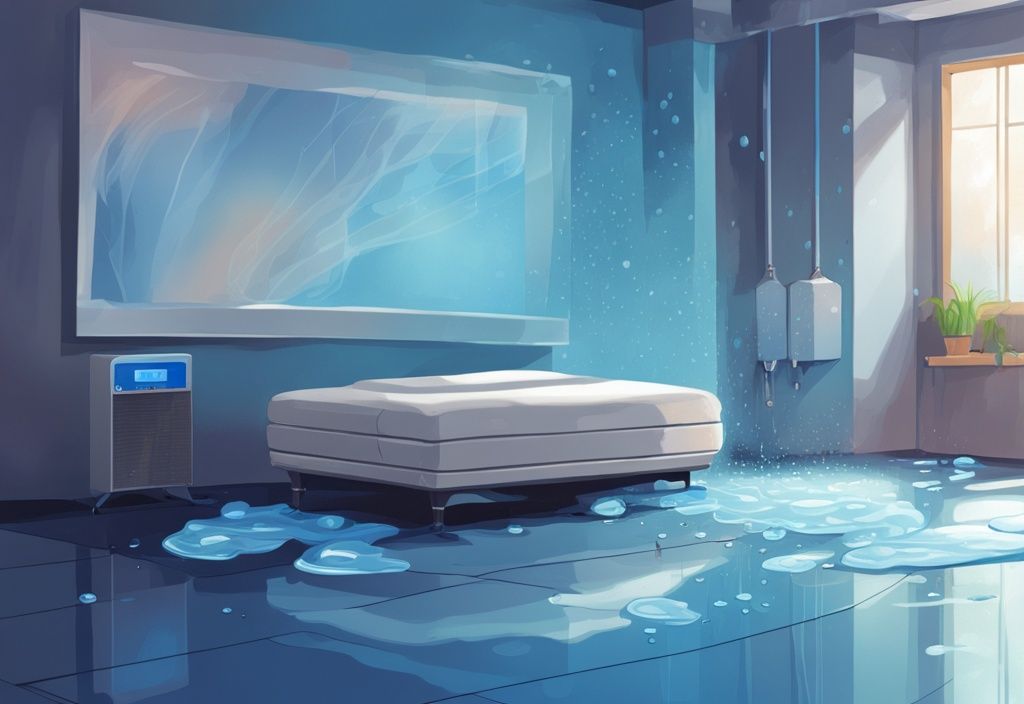
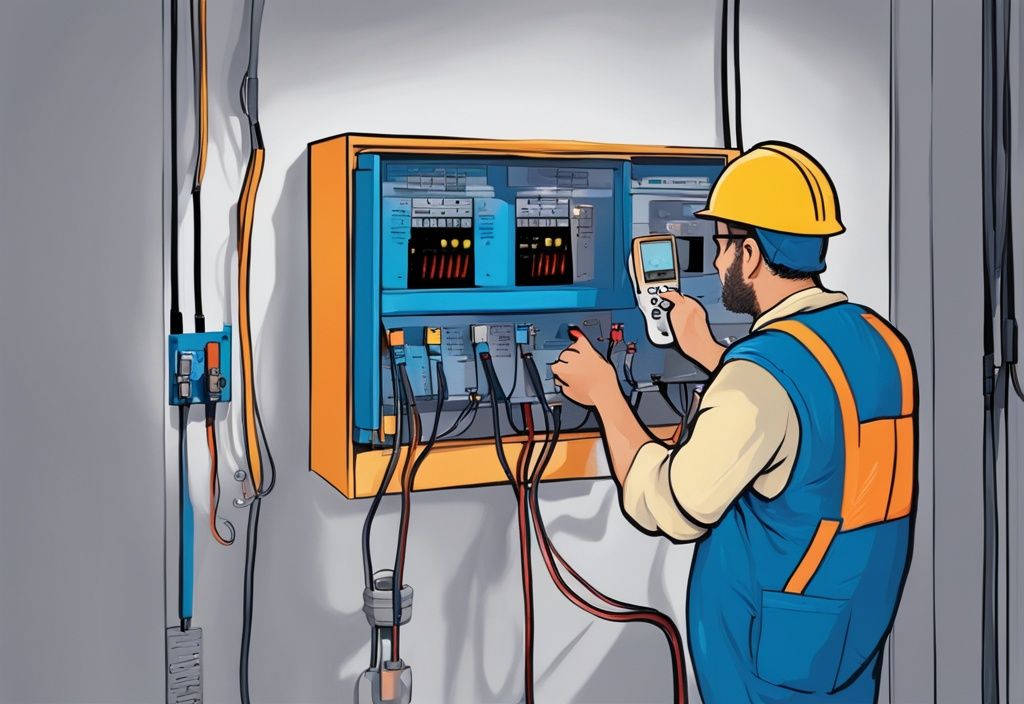
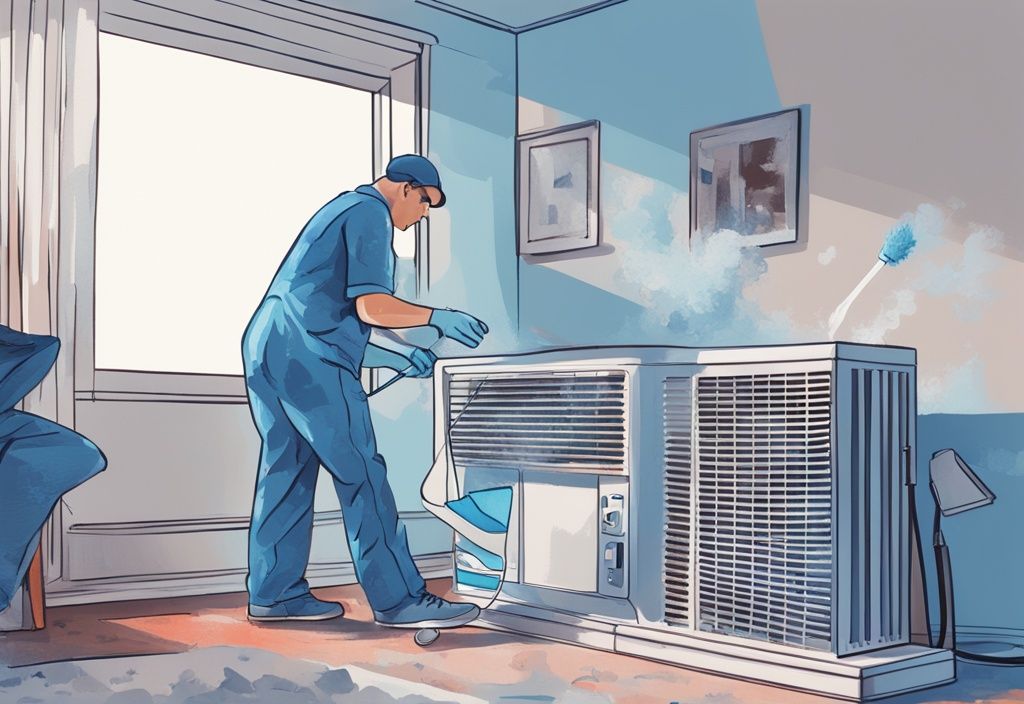
Post Comment